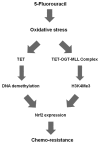Oxidative Stress, Nrf2, and Epigenetic Modification Contribute to Anticancer Drug Resistance
- PMID: 28133507
- PMCID: PMC5266370
- DOI: 10.5487/TR.2017.33.1.001
Oxidative Stress, Nrf2, and Epigenetic Modification Contribute to Anticancer Drug Resistance
Abstract
Nuclear factor E2-related factor 2 (Nrf2), a transcription factor, controls the expression of genes encoding cytoprotective proteins, including antioxidant enzymes that combat oxidative and electrophilic stress to maintain redox homeostasis. However, recent studies demonstrated that, in cancer, aberrant activation of Nrf2 by epigenetic alterations promotes high expression of cytoprotective proteins, which can decrease the efficacy of anticancer drugs used for chemotherapy. In this review, we summarize recent findings regarding the relationship between oxidative stress, Nrf2, epigenetic modification, and anticancer drug resistance, which should aid in development of new strategies to improve chemotherapeutic efficacy.
Keywords: Anticancer drug resistance; Epigenetic modification; Nrf2 transcription factor; Oxidative stress.
Figures



Similar articles
-
Emerging role of NRF2 in chemoresistance by regulating drug-metabolizing enzymes and efflux transporters.Drug Metab Rev. 2016 Nov;48(4):541-567. doi: 10.1080/03602532.2016.1197239. Epub 2016 Jun 20. Drug Metab Rev. 2016. PMID: 27320238 Review.
-
Emerging role of nuclear factor erythroid 2-related factor 2 in the mechanism of action and resistance to anticancer therapies.Cancer Drug Resist. 2019 Sep 19;2(3):490-515. doi: 10.20517/cdr.2019.57. eCollection 2019. Cancer Drug Resist. 2019. PMID: 35582567 Free PMC article. Review.
-
Epigenetic regulation of Keap1-Nrf2 signaling.Free Radic Biol Med. 2015 Nov;88(Pt B):337-349. doi: 10.1016/j.freeradbiomed.2015.06.013. Epub 2015 Jun 25. Free Radic Biol Med. 2015. PMID: 26117320 Free PMC article. Review.
-
Review of molecular mechanisms involved in the activation of the Nrf2-ARE signaling pathway by chemopreventive agents.Methods Mol Biol. 2010;647:37-74. doi: 10.1007/978-1-60761-738-9_3. Methods Mol Biol. 2010. PMID: 20694660 Review.
-
Reprint of: Nrf2/ARE-mediated antioxidant actions of pro-electrophilic drugs.Free Radic Biol Med. 2014 Jan;66:45-57. doi: 10.1016/j.freeradbiomed.2013.11.002. Epub 2013 Nov 18. Free Radic Biol Med. 2014. PMID: 24262357
Cited by
-
Evaluation of the Epigenetic Demethylation of NRF2, a Master Transcription Factor for Antioxidant Enzymes, in Colorectal Cancer.Rep Biochem Mol Biol. 2020 Apr;9(1):33-39. doi: 10.29252/rbmb.9.1.33. Rep Biochem Mol Biol. 2020. PMID: 32821749 Free PMC article.
-
The Role of Epigenetics in Neuroinflammatory-Driven Diseases.Int J Mol Sci. 2022 Dec 2;23(23):15218. doi: 10.3390/ijms232315218. Int J Mol Sci. 2022. PMID: 36499544 Free PMC article. Review.
-
Activation of the Nrf2/HO-1 signaling pathway contributes to the protective effects of baicalein against oxidative stress-induced DNA damage and apoptosis in HEI193 Schwann cells.Int J Med Sci. 2019 Jan 1;16(1):145-155. doi: 10.7150/ijms.27005. eCollection 2019. Int J Med Sci. 2019. PMID: 30662338 Free PMC article.
-
The orally active pterocarpanquinone LQB-118 exhibits cytotoxicity in prostate cancer cell and tumor models through cellular redox stress.Prostate. 2018 Feb;78(2):140-151. doi: 10.1002/pros.23455. Epub 2017 Nov 6. Prostate. 2018. PMID: 29105806 Free PMC article.
-
Impact of Coenzyme Q10 Administration on Lead Acetate-Induced Testicular Damage in Rats.Oxid Med Cell Longev. 2020 Jun 2;2020:4981386. doi: 10.1155/2020/4981386. eCollection 2020. Oxid Med Cell Longev. 2020. PMID: 32566085 Free PMC article.
References
Publication types
LinkOut - more resources
Full Text Sources
Other Literature Sources

